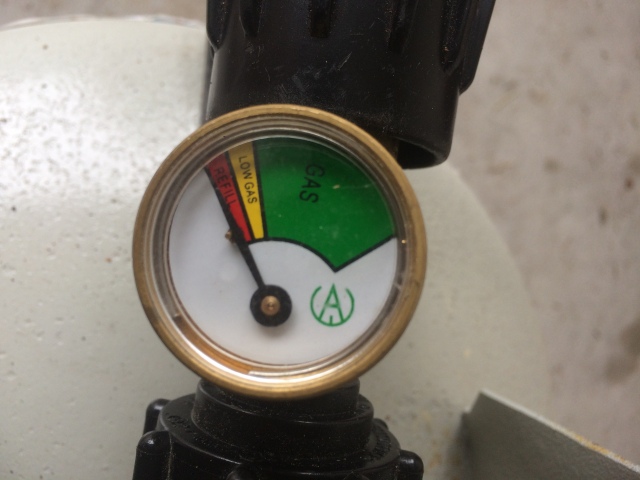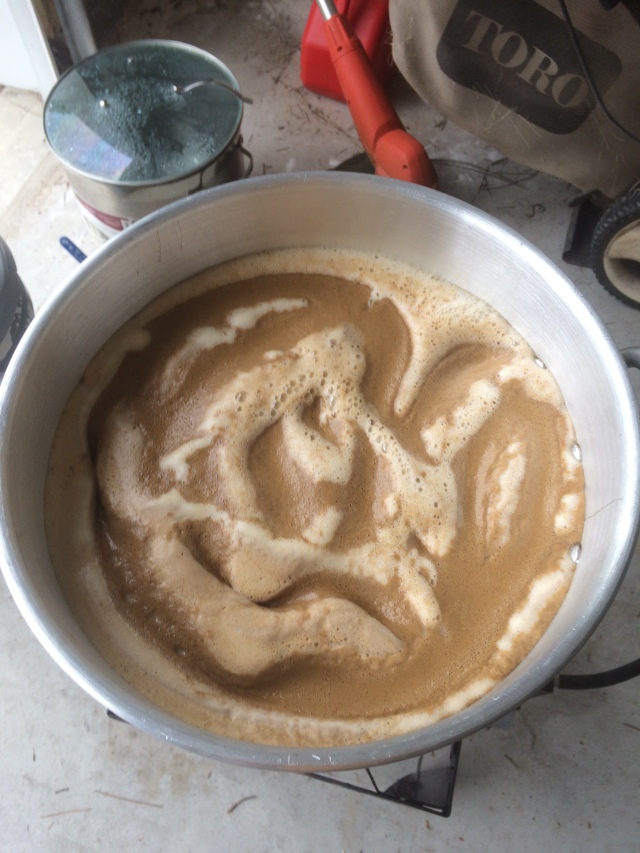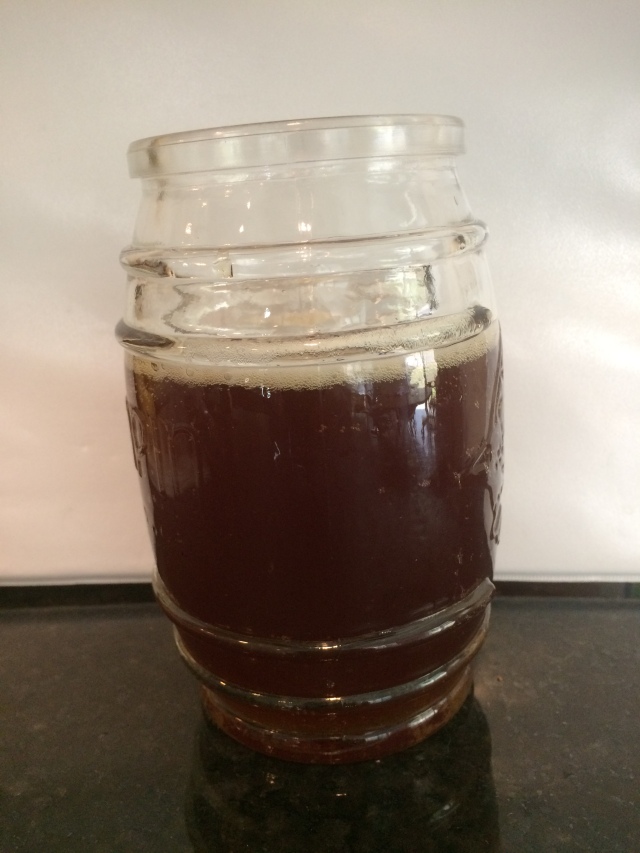This post is one in a series of making small adjustments to a single recipe in order to improve it, learn more about the impact each ingredient has on the finished product, and the art of recipe creation. The rest of the series can be found here.
Brew Day
My last few brew days have had to be squeezed in to otherwise unaccommodating timeslots to make them happen at all; this brew day was no exception. If nothing else, I’ve become the king of multitasking. Tired, but determined to brew, I set my alarm to go off early that Saturday morning (which is no small feat considering my one-year-old had spent the night with her grandparents and it was the one morning for months I could try to stave off the eternal exhaustion that comes with small children).
After a 1.25 hour mash, I drained my mash tun, filled it back up with sparge water, and quickly got in the car to go pick up my daughter—extending the amount of time I normally let my sparge water sit in the grains by around 45 minutes. Once I was back and ready to commit to a brew day with no more interruptions, I finished collecting my boil volume and lit the flame under my burner.
And then I ran out of propane. Right as the wort was starting to foam, my propane tank gave up. I use my propane tank with my grill as well, and the last time I had grilled the gauge showed a mostly full tank—the liar. While this was a surprise, it was better than running out of propane in the middle of a boil.

Once I returned with a new propane tank, the rest of the brew day went smoothly—for the most part. Just prior to my wort starting to boil, the foam started to form white, swirling shapes that I’ve never seen happen before (I’m accustomed to my break remaining tan). It was shortly after this that I checked my wort’s pre-boil gravity and realized that this difference was possibly due to a higher than usual protein content since I had definitely overshot my target gravity. Doing some quick math, I diluted my boil but apparently miscalculated. My OG still came in much higher than intended.
Some time after the fact, I consulted the notes from my previous brew day and realized that despite previously being unable to pinpoint the cause of my fluctuating OG, this time was entirely my fault. I simply misremembered a number and ended up not collecting enough pre-boil wort. This mistake combined with the miscalculation above landed me at imperial status for this red IPA. Oops.

Recipe
Iteration 6 was a solid IPA-strength ABV, had the malt character I wanted, and was definitely hoppy enough for an IPA. I was mostly pleased with this iteration, but there were a few things that stuck out to me as items worth changing.
Although Simcoe is a delightful hop, it seemed that its unique character was not working with this particular beer (at least in the way that I had envisioned it originally). The hop character had also been left a little one-dimensional, and I wondered if this had to do with removing my middle-boil hop addition. Lastly, although the malt flavor was spot on and the hop character was IPA-worthy, the balance of the two was off, hiding the malt a little more than desired. This left me with a few questions on how to move forward:
- Should I replace the Simcoe hop addition, and if so, what should I replace it with?
- Should I add a 30 minute hop addition back into my hop schedule, and if so what hop?
- Can I improve the balance of hop and malt character?
Since the Simcoe addition was providing more of a dank/slightly catty quality that wasn’t exactly working with the other flavors in this beer, this meant that this addition had to go. For this beer, I wanted a more citrus-centered hop character than I was getting. The cascade and centennial additions would definitely provide some of that, but they also provided floral notes that, although pleasant in the beer, I wanted more as a backdrop to the citrus. This meant that I needed to add another hop to the mix instead of adding more of what I already had. This decision was fairly simple for me, since one of my favorite hops is Amarillo and it has that citrus character I was looking for.
The decision on whether or not to add a 30 minute addition back in wasn’t that difficult either. After running my hop additions into a recipe calculator, I realized that there wasn’t that much difference in estimated IBU if I used half an ounce of magnum at 60 minutes and half an ounce at 30 minutes as opposed to the full ounce at 60 minutes. I thought this slightly different bitterness level might also allow a little more malt to shine through while still being hop-centric (answering my final question on this recipe). These answers (and overshooting my OG) landed me at this recipe:
- Mashed at 150⁰ F for 1.25 hrs.
- 10 lbs. 2-Row
- 1.2 lbs. Crystal 120
- 1 lb. Vienna
- Boiled for 1 hr.
- 0.5 oz. Magnum (60 min) at 14.7% AA
- 0.5 oz. Magnum (30 min) at 14.7% AA
- 0.5 oz. Cascade (15 min) at 5% AA
- 0.5 oz. Centennial (5 min) at 9.7% AA
- 0.5 oz. Amarillo (0 min) at 12.9% AA
- Pitched US-O5
- OG: 1.073
- FG: 1.010
- ABV: 8.3%
- Dry hopped 0.5 oz. Cascade, 0.5 oz. Centennial, and 0.5 oz. Amarillo for 5 days.
- Bottled and primed with 4 oz. of priming sugar.
Tasting
The color of this version was almost perfectly red. The clarity of the beer detracts from that, but it’s definitely red. With the same grain bill as last time, I imagine that the difference came from a variation in the total volume gathered (the desired amount this time), moving this iteration closer to my approximated and target SRM. Unfortunately, this beer poured with a minimal head that dissipated quickly. As previous iterations have had positive head/retention characteristics and I didn’t change anything about my process this time, I want to point to the higher OG/ABV as the reason for this (as this can affect head-forming proteins), but I’m not fully convinced that this variation is enough to make that drastic of a difference.

The aroma of this beer was one of (in order of prominence) plum, citrus, apricot, and black cherry. The apricot is new and not unpleasant—a factor of adding Amarillo to this version, I’m sure.
One surprising element of this brew was how closely the taste matched the aroma. My past experience has led me to expect a slight (or sometimes comparatively significant) difference between these two, even though the sensory perception of taste is greatly impacted by smell. There have been things I’ve smelled but not tasted, and vice versa; more often the prominence of aromas does not match the prominence of similar flavors (e.g., citrus aroma is stronger than the citrus flavor). This iteration, though, tasted almost exactly the same as the aroma led me to think it would taste. I didn’t taste the plum that I had smelled, but the citrus and apricot flavors were there in the same level as they were in the aroma. A cherry flavor (though admittedly not the black cherry I smelled) was also present.
Goals for the Next Brew
While this is a pleasant beer, it is lacking the hop punch that Iteration 6 had. With all the current discussion about hop oils and their impact on aroma and flavor, I looked there to see if I could pinpoint a likely cause of this variation, despite having used the same weight of hops. The information I found listed Simcoe (used in Iteration 6) as having a range of 0.8-3.2 mL/100g of total oil and Amarillo as having a range of 1-2.3 mL/100g of total oil. Since Simcoe has a greater range of potential oil content (both higher and lower), I’ll venture a guess that the Simcoe I used had a higher overall oil content than the Amarillo I used. Unfortunately, I can’t verify that this is true with how and where I bought my hops.
Whatever the cause, the desired hop aroma was definitely missing in this iteration, and that is something I want to fix in the next version of this recipe. I also want to see if I can get more citrus aroma and flavor than I did in this version. I enjoy the apricot flavor of the Amarillo addition and want to keep that, but I did not get as much citrus flavor as I expected from this hop (based on prior experience).
Yet another variation in efficiency has changed my recipe unintentionally (as well as my incorrect calculations that were intended to correct the situation). I am going to shoot for a lower (and more appropriate) ABV for the next iteration.
The questions I’m left with after this brew are:
- Which additional hop should I add to the dry hop to improve aroma (a new hop or one already in use)?
- Which hop should I use to get a more prominent citrus flavor?
- Should I add more hops at flameout in addition to more dry hops? If so, which ones?
Recipe Progression
One item I’ve gotten feedback on is the increasing difficulty in keeping up with all the different versions of this recipe. I can’t help but agree. To help with this and to provide a more visual representation of the progression of this recipe, I’ve put together the chart below.
| Iteration 1 | Iteration 2 | Iteration 3 | Iteration 4 | Iteration 5 | Iteration 6 | Iteration 7 | |
| Base Malt 2-row | 10.25 lbs. | 10.25 lbs. | 10.25 lbs. | 9 lbs. | 10 lbs. | 10 lbs. | 10 lbs. |
| Crystal Malt | 1 lb. C80 | 1 lb. C120 | 0.75 lbs. C120 | 1.25 lbs. C120 | 1 lb. C120 | 1.2 lbs. C120 | 1.2 lbs. C120 |
| Other Malt | 0.5 lbs. Special B | 1 lb. Munich | 1 lb. Vienna | 1 lb. Vienna | 1 lb. Vienna | ||
| 60 min. hop | 0.5 oz. Simcoe | 0.5 oz. Simcoe | 0.5 oz. Simcoe | 0.5 oz. Simcoe | 0.5 oz. Simcoe | 1 oz. Magnum | 0.5 oz. Magnum |
| 30 min. hop | 0.5 oz. Simcoe | 0.5 oz. Simcoe | 0.5 oz. Simcoe | 0.5 oz. Simcoe | 0.5 oz. Simcoe | 0.5 oz. Magnum | |
| 15 min. hop | 0.5 oz. Cascade | 0.5 oz. Cascade | 0.5 oz. Cascade | 0.5 oz. Cascade | 0.5 oz. Cascade | 0.5 oz. Cascade | 0.5 oz. Cascade |
| 10 min. hop | 0.5 oz. Centennial | ||||||
| 5 min. hop | 0.5 oz. Centennial | 0.5 oz. Centennial | 0.5 oz. Centennial | 0.5 oz. Centennial | 0.5 oz. Centennial | 0.5 oz. Centennial | |
| 0 min. hop | 0.5 oz. Simcoe | 0.5 oz. Amarillo | |||||
| Dry hop | 0.5 oz. Cascade & Centennial | 0.5 oz. Cascade & Centennial | 0.5 oz. Cascade & Centennial | 0.5 oz. Cascade & Centennial | 0.5 oz. Cascade & Centennial | 0.5 oz. Cascade, Centennial, & Simcoe | 0.5 oz. Cascade, Centennial, & Amarillo |
| OG | 1.059 | 1.064 | 1.056 | 1.052 | 1.056 | 1.066 | 1.073 |
| FG | 1.008 | 1.010 | 1.008 | 1.010 | 1.008 | 1.010 | 1.010 |
| ABV | 6.7% | 7.1% | 6.3% | 5.5% | 6.3% | 7.4% | 8.3% |
